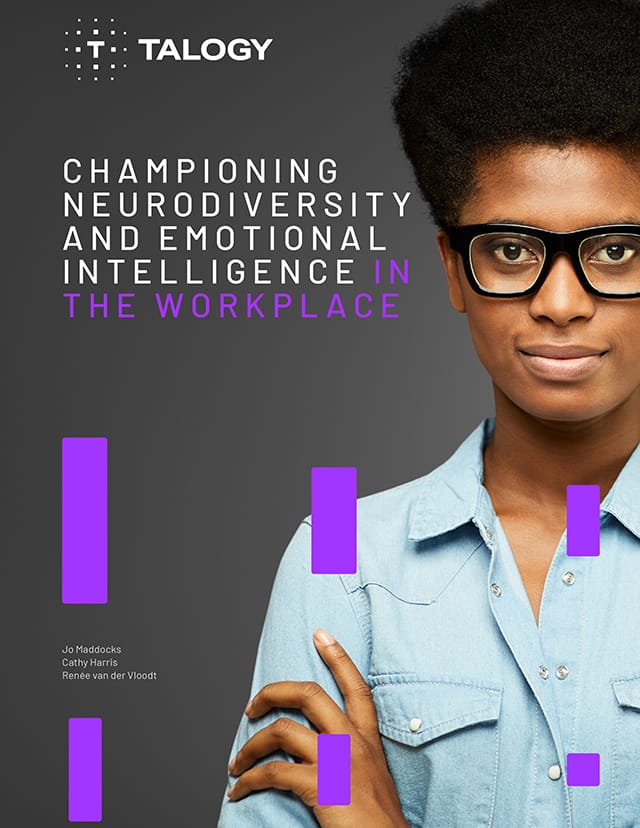Written by Bill Davies, Principal Consultant
Emotional intelligence (EI) has gone from being a ‘fluffy fad’ to a critical aspect of work, be it leadership, team relationships, engagement, and much more. The more you look at the theory and application of EI, the more complex it can seem. But what really enables EI and how can you develop it?
Here is what I’ve taught in coaching programs over the past 25 years, which aligns with Talogy’s research in this expanding and important field.
Creating capacity for EI
EI is a set of skills, attitudes, and behaviours, but it is also a variable. I can be emotionally intelligent one moment and emotionally stunted the next. So, developing EI is about being more emotionally intelligent more of the time.
When we are tired, irritable, or vulnerable, we can lose our capacity for EI and can be easily triggered to what are termed ‘defensive habits.’ Some examples of these habits can include micromanaging, aggressive body language, and passivity/helplessness. We now know that the brain is not built for multi-tasking and that, particularly for complex activities such as communication, problem-solving, and decision making, we need to work sequentially with focus.
So, a core starting point for EI is this ability to manage our lives and create capacity. Arguably, this means having a more disciplined approach to how we manage our energy and work in a brain-friendly way. Taking time each day to release tension and calm the mind is an important starting point. Find a moment every day to stop and recharge rather than ploughing through or waiting until the evening, the weekend, or a holiday. Without regular renewal each day, it can mean your downtime becomes either stressful, low energy, or both.
Managing reactions
Having more energy and capacity enables us to take on the next core element – managing our emotional reactions. This is central to managing stress and anxiety. Many authors have commented on how easily we can be ‘emotionally hijacked’ or ‘triggered.’ Humans are wired for threat and the build-up of frustrations and anxieties throughout the day can undermine our EI. Our emotional brains tend to be quite binary, moving from “I’m OK” to “I’m not OK” regularly, and often without us being aware.
All emotions have a purpose, and the negative emotions are largely there to keep us safe. Note that negative emotions does not mean bad emotions, they normally mean that some needs, values, or expectations are not being met. This can be a useful way to understand the value of these emotions and the basis for acting on the understanding (when we have calmed down).
As human beings we can improve, impact, and create the emotional life we want to a degree. But this does take some brain training, and again, discipline. Therefore, EI is a practice, not something we have or don’t have, it’s the practice of noticing, pausing, accepting, and choosing.
The practice of mindfulness and becoming healthily self-reflective will ‘rewire’ our brains and help us to achieve a calmer inner life that makes us more resilient and able to be more emotionally intelligent. Techniques such as 7/11 breathing, naming emotions, and sharing how we are feeling gives us more control over our reactions. However, we are human, and this is not about being forever peaceful – it is more about learning how to manage our emotional self to positively impact mental health and resilience.
Identifying emotions and developing awareness
The fundamentals so far point to foundational aspects that can support us being emotionally intelligent more often. However, as mentioned, EI is a practice, and this is where understanding the different components of EI can be very helpful. Talogy’s framework breaks it down into these components: attitude, feeling, and behaviour.
As this model illustrates, our attitudes, feelings, and behaviours all impact each other both personally and interpersonally. For example, developing the awareness of my emotions can aid my awareness of the emotional states of others, and being more aware generally puts me in a better place to choose appropriate behaviours. This is as long as we act on the awareness. If I do act, then my intentions (attitudes) will deeply impact how my actions land with others. The more I act in a focused intentional way, the more my self-regard can improve. This is a system approach. Developing EI requires focus and discipline, and habit change research suggests that this will take time – a minimum of 21 days.
Take control of your emotional intelligence
The secret of increasing your EI is to investigate your strengths and weaknesses systematically. Build capacity first, then prioritise by calmly understanding your emotions and what actions might be useful to take so you manage, and finally utilise, them effectively. This will allow you to create new habits that are in line with your desired outcomes. Increasing your emotional intelligence will enable you to properly manage challenges to your needs, values, and expectations. You can create the emotional life you want.
Takeaway tips to increase EI:
- Build capacity through taking regular breaks, pausing to check on state/awareness, and doing tasks sequentially with a pause between where possible (the world will try to intrude).
- Capacity will enable awareness, so build on this through disciplines such as mindfulness or journaling and through expressing emotion with trusted others.
- And if you want to go to the next level, focus on a small change for at least 21 days. And consider the use of a proven and validated tool for doing it with feedback and coaching.


